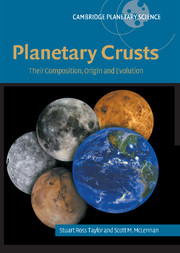Book contents
- Frontmatter
- Contents
- Preface
- Acknowledgments
- List of abbreviations
- Prologue
- 1 The planets: their formation and differentiation
- 2 A primary crust: the highland crust of the Moon
- 3 A secondary crust: the lunar maria
- 4 Mercury
- 5 Mars: early differentiation and planetary composition
- 6 Mars: crustal composition and evolution
- 7 Venus: a twin planet to Earth?
- 8 The oceanic crust of the Earth
- 9 The Hadean crust of the Earth
- 10 The Archean crust of the Earth
- 11 The Post-Archean continental crust
- 12 Composition and evolution of the continental crust
- 13 Crusts on minor bodies
- 14 Reflections: the elusive patterns of planetary crusts
- Indexes
- References
13 - Crusts on minor bodies
Published online by Cambridge University Press: 22 October 2009
- Frontmatter
- Contents
- Preface
- Acknowledgments
- List of abbreviations
- Prologue
- 1 The planets: their formation and differentiation
- 2 A primary crust: the highland crust of the Moon
- 3 A secondary crust: the lunar maria
- 4 Mercury
- 5 Mars: early differentiation and planetary composition
- 6 Mars: crustal composition and evolution
- 7 Venus: a twin planet to Earth?
- 8 The oceanic crust of the Earth
- 9 The Hadean crust of the Earth
- 10 The Archean crust of the Earth
- 11 The Post-Archean continental crust
- 12 Composition and evolution of the continental crust
- 13 Crusts on minor bodies
- 14 Reflections: the elusive patterns of planetary crusts
- Indexes
- References
Summary
Where observation is concerned, chance favors only the prepared mind
(Louis Pasteur)Minor bodies in the Solar System
Apart from the major planets, a host of minor bodies are also in orbit around the Sun or around the planets. However, no commonly agreed definitions can be found for the bodies that formed by a variety of stochastic processes in the nebula. Furthermore the extra-solar planetary systems mostly do not resemble our own. This has led to sharp debates over what does or does not constitute a planet (Chapter 1, Ref. 2) and the matter has been resolved by adding qualifiers. So the Solar System consists of eight major planets, each one distinct and a huge variety of objects that include the rocky bodies that inhabit the asteroid belt, the satellites of the major planets and the multitude of small icy bodies in the Edgeworth–Kuiper Belt that are usually referred to as Trans-Neptunian Objects or TNOs that possibly represent material from the primordial solar nebula. Perhaps the most interesting observation about the small bodies is that there is little uniformity. Dave Stevenson has noted that “the four giant planets exhibit a startling diversity of satellite systems” while Brad Smith has remarked that “the sense of novelty would probably not have been greater if we had explored a different Solar System”.
Minor bodies are typically composed of various mixtures of the ice and rock components of the original nebula. Gases are strongly depleted.
Information
- Type
- Chapter
- Information
- Planetary CrustsTheir Composition, Origin and Evolution, pp. 325 - 351Publisher: Cambridge University PressPrint publication year: 2008
